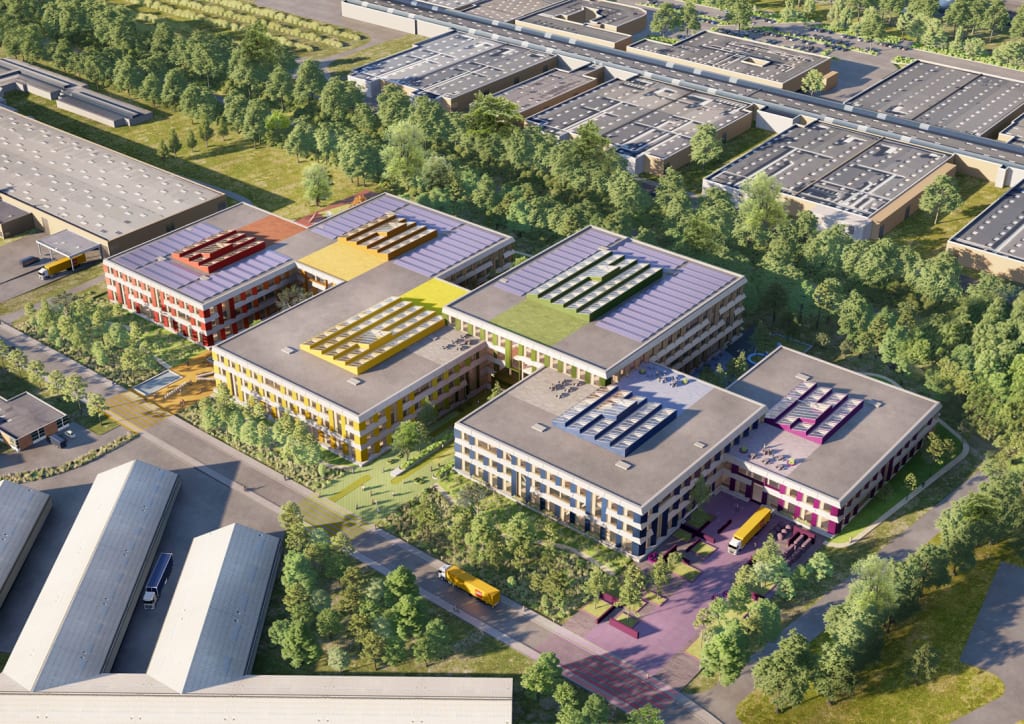You are looking at the future center of the brick cosmos: the new Lego Innovation Campus. Right now, the people who create your favorite innovative brick products are scattered in different buildings around the company’s hometown of Billund, Denmark. But in 2027, they will gather at Lego’s new campus, in six color-coded buildings made of sustainable timber.
According to Julia Goldin, Chief Product & Marketing Officer at the Lego Group, “the new Innovation Campus in Billund will be our global creative center for product and design excellence. It’s where every new Lego experience will come to life.” The design of the new campus is itself an embodiment of the modular spirit of Lego system—each piece connecting seamlessly into a larger world.
Its planning reflects this philosophy, which is visible in its key architectural components like the PlayWay, a central hall connecting all of the campus’ buildings. There are also sprawling atriums in patios illuminated by natural light through skylights that will open with good weather, and the open spaces that Lego calls loops, where people can meet spontaneously. Everything is interconnected as a way to, in theory, inspire cross-pollination of ideas among the teams. All these elements in the Lego Innovation Campus act as connective hubs, Lego says, facilitating an open dialogue between different functions and allowing different teams to build off each other’s energy and expertise.
The PlayWay is a central hall that connects all the campus’ buildings and its elements. It also contains spaces designed to encourage employees to celebrate impromptu collaborations in a similar way that different kids connect to play in the Lego House, the company’s interactive museum nicknamed the “home of the brick.”
The new campus seems to share the same philosophy that drove the Lego House‘s design, which has a similar division of color-coded areas interconnected to a central open atrium, featuring a gigantic Tree of Creativity made of bricks that grows each year. In the Lego House, each of those areas is dedicated to the core competencies set in the “Learning through play” philosophy, a set of education ideals that codifies how humans learn and create. “We believe in the power of play,” Goldin says. “And this new campus will ensure that creativity is the beating heart of everything we do.”

Bricks, bricks, bricks
The new campus was created by the Danish firm CEBRA Architects, based in Aarhus, but hundreds of Lego employees provided input at various stages of the design. Lego says the creative process involved creating and building the campus using bricks—then rebuilding it to iterate on ideas. This infinite loop of designers using bricks to design buildings that will be home for designers that will use bricks to design new objects made of bricks may open a dark magical portal to a parallel dimension where Everything Is Awesome.
One really cool feature of the Innovation Campus is the world’s largest library of Lego elements, featuring a collection of roughly 20,000 pieces. It’s a living archive of creativity—and a nod to the sheer range of possibilities inherent in a single brick. The library is not just an archive, but a resource that designers and product developers will draw on as they conceptualize future sets, ideas, and experiences.

Beyond fostering creativity, the Lego Innovation Campus has another focus: sustainability. This has been a core part of the Danish company’s corporate plans, despite its struggles to find a green replacement to the petroleum-based plastic used to make Lego bricks. But Lego says the new campus is built around this principle from the selection of materials to energy use strategies.
“Sustainability has been at the core of the design,” Goldin says. “It’s about more than just a building—it’s about making responsible choices in every part of the process, from material sourcing to energy use.”
The building is constructed with Forest Stewardship Council (FSC)-certified timber for its core and walls. FSC certification guarantees that the wood is sourced from responsibly managed forests, minimizing environmental impact while maintaining the structural integrity required for such an expansive space. The design is aiming to get LEED Platinum certification, one of the highest standards for sustainable buildings, which evaluates everything from energy efficiency to water conservation. Achieving Platinum means reducing energy use by at least 30%, restoring local biodiversity through native plantings, and implementing advanced water recycling systems to minimize consumption.


